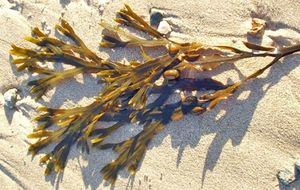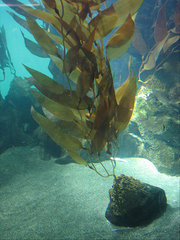Brown algae (Ecology)
Contents
Brown algae
Brown algae, also known as Phaeophyceae, are a set of species comprised chiefly by marine multicellular algae, including many seaweeds of the colder Northern Hemisphere waters. They play a key role in marine environments both as food, and for the habitats they create, with their intricate and sometimes large architecture. For example, some members of the kelp genus Macrocystis may attain lengths of up to 60 meters, and form prominent mostly submerged kelp forests; along a portion of the Pacific coast of California, these kelp forests form an intrinsic element of the habitat of the endangered Southern sea otter. Another example of a brown algae is genus Sargassum, which creates unique habitats in the tropical waters of the Sargasso Sea. Many brown algae such as members of the order Fucales are commonly found along rocky seashores. Some brown algae are used as food for humans, and also for food additives as well as pharmaceuticals, and even in sound reducing building materials. Some brown algae species such as Ascophyllum nodosum have such great commercial importance that they are subjects of extensive scientific investigation.[1]
Taxonomy
Brown algae belong to a large taxonomic group, the Heterokontophyta, a eukaryotic group of organisms chiefly distinguished by having chloroplast surrounded by four membranes, suggesting an origin based on asymbiotic relationship between a basal eukaryote and a second eukaryote species. There are 18 recognized orders within the brown algae as well as two families of incertae sedis(or uncertain relations). Most brown algae contain the pigment fucoxanthin, which is responsible for the iconic greenish-brown color, from which the group name dervies. Brown algae are unique among heterokonts in developing into multicellular forms with differentiated tissues, although they reproduce by means of flagellate spores and gametes, which closely resemble other heterokont cells. Genetic studies show their closest relatives to be yellow-green algae. The number of brown algae species worldwide was earlier estimated to be between 1500 and 2000,[2] but is now counted as above 2800.
Physical description
Brown algae are filamentous, and may be macroscopic or microscopic species, some being polysiphonous. Some brown algae manifest crusts, cushions or are hollows, often taking on remarkable bulbous appendages; moreover, some species mature to form massive leathery fronds.[3]
Reproduction
The reproductive life cycle of brown algae evinces considerable variability among the genera. As an example, the life cycle of genus Laminaria, commonly recognized as a genus of large kelp, consists of a diploid generation. The organisms within this genus produce sporangia from specialized microscopic structures, which then divide by meiosis prior to being released. Since they are haploid, there are equal numbers of male and female spores.[4] With the exception of the Fucales, all brown algae have a life cycle which consists of an alternation between haploid and diploid forms. Brown algae growing in brackish waters are almost solely asexual.
Habitat
Various families within the brown algae are adapted to a wide variety of marine ecological niches including tidal splash zone, rocky marine pools, the intertidal zone, coral reefs and moderately deep [[coast]al zone] waters. The brown algae are an important constituent of a number of brackish water ecosystems, and four species are restricted to life in fresh water.[5] A large number of Phaeophyceae are either intertidal or upper littoral, and they are predominantly cool and cold water organisms that benefit from nutrients upwelling, which is driven by vertical cold water currents or riverine influxes from land; genus Sargassum is a noteworthy exception to this generalization.

